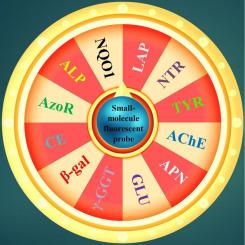酶激活小分子荧光探针在生物系统中的研究进展
IF 23.5
1区 化学
Q1 CHEMISTRY, INORGANIC & NUCLEAR
引用次数: 0
摘要
酶是一种特殊的具有催化功能的生物大分子,在支持正常的生理活动中起着至关重要的作用。酶活性失调与许多疾病的发生和发展直接相关。为了研究酶在生物体内的分布、表达水平和潜在的机制,开发一种可靠的酶活性检测策略方法具有重要意义。幸运的是,小分子荧光探针在酶活性检测方面具有灵敏度高、生物相容性好、适应性强、实时检测等显著优势。此外,由于其结构易于修饰,小分子荧光探针可以满足监测生命系统中酶波动的各种需求,有助于探索其在特定疾病中的生理功能,为个性化治疗提供重要信息。因此,本文就具有代表性的酶激活小分子荧光探针的设计策略、鉴定原理、应用及病理生理机制进行综述。我们的最终目标是制备高质量的荧光探针,为某些疾病的早期预警和治疗提供有力的工具。本文章由计算机程序翻译,如有差异,请以英文原文为准。

Recent progress of enzyme-activated small-molecule fluorescent probes in biological systems
Enzymes are specialized biological macromolecules with catalytic functions that play crucial roles in supporting normal physiological activities. Dysregulated enzyme activity is directly connected with the onset and progression of numerous diseases. To investigate their distribution, expression levels, and underlying mechanisms of enzyme in living organisms, developing a credible strategy method for detecting enzyme activity is momentous. Fortunately, small-molecule fluorescent probes demonstrated significant advantages in the detection of enzyme activity, including high sensitivity, satisfactory biocompatibility, in suit and real-time detection. Moreover, based on the easy modifying their structures, small-molecule fluorescent probes can meet various needs for monitoring enzyme fluctuations in living systems, facilitating the exploration of its physiological function in specific diseases, providing vital information for personalized therapy. Therefore, this review aims to summarize the design strategies, identification principles, applications, and pathophysiological mechanisms of representative enzyme-activatable small-molecule fluorescent probes. Our ultimate goal is conduced to prepare high-quality fluorescent probes, which are served as powerful tools for the early warning and therapy of certain diseases.
求助全文
通过发布文献求助,成功后即可免费获取论文全文。
去求助
来源期刊

Coordination Chemistry Reviews
化学-无机化学与核化学
CiteScore
34.30
自引率
5.30%
发文量
457
审稿时长
54 days
期刊介绍:
Coordination Chemistry Reviews offers rapid publication of review articles on current and significant topics in coordination chemistry, encompassing organometallic, supramolecular, theoretical, and bioinorganic chemistry. It also covers catalysis, materials chemistry, and metal-organic frameworks from a coordination chemistry perspective. Reviews summarize recent developments or discuss specific techniques, welcoming contributions from both established and emerging researchers.
The journal releases special issues on timely subjects, including those featuring contributions from specific regions or conferences. Occasional full-length book articles are also featured. Additionally, special volumes cover annual reviews of main group chemistry, transition metal group chemistry, and organometallic chemistry. These comprehensive reviews are vital resources for those engaged in coordination chemistry, further establishing Coordination Chemistry Reviews as a hub for insightful surveys in inorganic and physical inorganic chemistry.
 求助内容:
求助内容: 应助结果提醒方式:
应助结果提醒方式:


